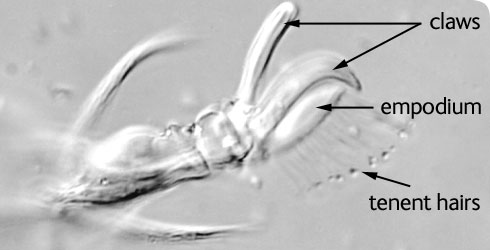Biology
Life cycle
The life stages comprise:
- egg
- six-legged larva
- eight-legged protonymph (sometimes called nymph I)
- tritonymph (sometimes called nymph II or deutonymph)
- adult (female and male)
Males have never been observed in North American populations. They are said to be rare in European populations, but when they do occur, several appear together.
Two male forms have been identified. Apart from the genitalia, homeomorphic (= homomorphic) males are similar to the female. Heteromorphic ones mainly differ in their larger size, heavier sclerotization and more elongate palps.
Eggs are laid in clusters in nests, eg. in bran flakes. About half are deposited in the first nest and just over a quarter in the second. Subsequently, nest-building increases in frequency as egg-laying (oviposition) decreases. The number of eggs laid decreases if nests are disturbed. The eggs have a sticky surface, although are not very firmly stuck down. They are loosely bound together with silk strands.
Fecundity and development are affected by environmental conditions and prey type. The total number of eggs laid per female ranges from approximately 19--317.
Within the temperature range of 12--30˚C, the time taken for an egg to develop to an adult decreased with increasing temperature. At 18.5˚C it took 33.8 days and at 25°C 15.4 days. (Boczek, 1959; Summers and Witt, 1972; Summers et al., 1972; Hughes, 1976; Zdárková, 1979; Berreen and Metwally, 1984; Volgin, 1987; Barker, 1991; Zdárková and Horak 1999)
Reproduction
Males are uncommon (so far, they have not been found in North American populations), but pairing between the sexes has been recorded. The subsequent production of viable eggs did not provide evidence of fertilisation because C. eruditus reproduces by thelytoky, ie. unfertilized eggs give rise to females. (Edwards, 1952; Summers et al., 1972; Hughes, 1976)
Dispersal
Cheyletus eruditus can be transported over long distances in infested food. On a local level, dispersal occurs when prolonged starvation induces a period of wandering. (Summers and Witt, 1972)

